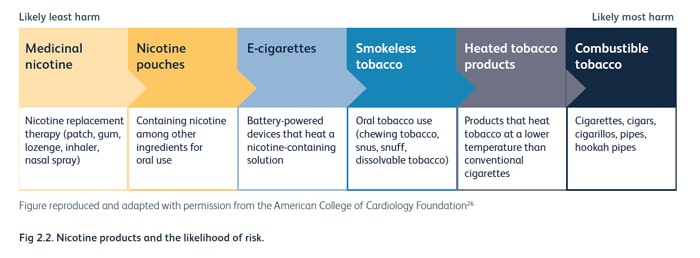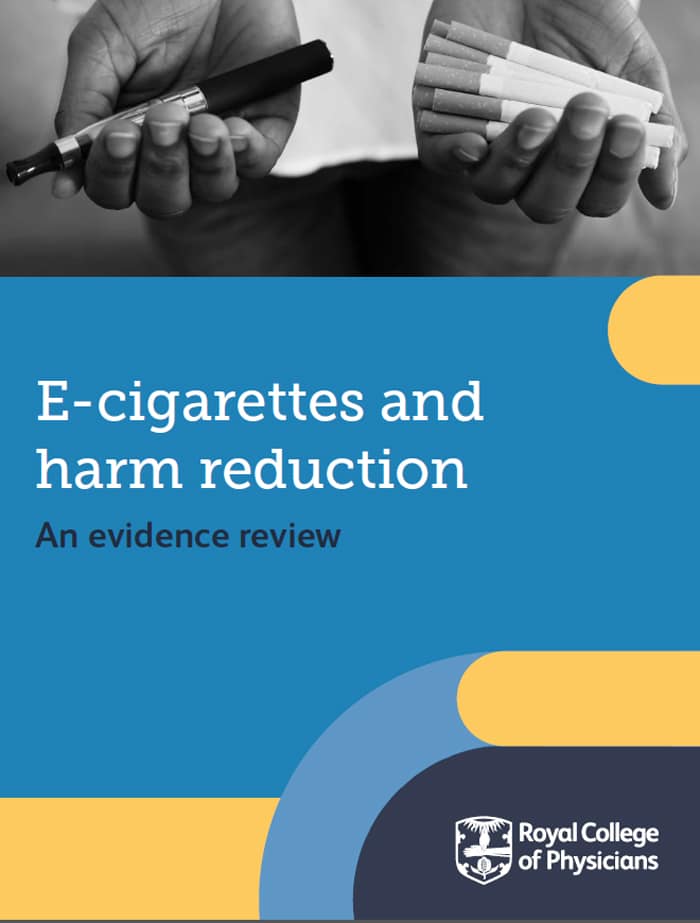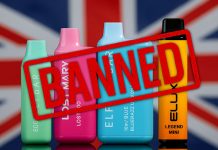The RCP (Royal College of Physicians) has published a report on the role of vapes in harm reduction.
You can view the report here: “E-cigarettes and Harm Reduction: An evidence review“.
The link above takes you to an introduction page and at the bottom are the links for downloading the actual reports.
The Report
The introduction page states that the report investigates how vapes can be used in smoking cessation whilst also tackling the issue of underage vaping. Also those who have never smoked are being discouraged from vaping.
Inside the report are over 50 recommendations in various areas – the main ones are summarised below…
- Price – raising their price by introducing an excise tax and minimum unit pricing while banning multi-buy purchases but making sure they remain a less expensive option for adults using them to quit smoking.
- Promotion – restricting ‘point of sale’ in store promotional materials and product visibility, and restricting promotion on social media.
- Purchase – ensuring Trading Standards services are sufficiently resourced to effectively enforce e-cigarette sales legislation and reduce underage sales.
- Products – making products less appealing to young people by introducing standardised packaging and flavour descriptors. Require manufacturers to limit the production of toxic substances from vapes, require the Medicines and Healthcare products Regulatory Agency (MHRA) to independently verify product contents, provide advice to consumers on which are the safest products if using them to stop smoking and require manufacturers cover the costs of recycling.
As you can see the price area is disappointing calling for increased pricing and taxes on vaping. Something which the NNA (New Nicotine Alliance) and Vapers.org.uk are trying to fight – more info on the No Vape Tax campaign is here.
I do agree with the issue of Trading Standards not having enough resources to tackle illicit vaping products. With the upcoming Disposable Vape Ban this could be a bigger issue than it already was.
My Conclusions
This is quite a detailed document (267 pages) which I have only briefly summarised above.
To be perfectly honest I have not fully read it all – but I have poured over the Executive Summary (you can access it here – PDF download) which would be a good place to start for anyone scared by the full 267 page version!
But I have compiled some of the main points I have found below.
Vaping As Harm Reduction
It is in general very positive towards vaping as a method of Tobacco Harm Reduction (THR) but I do not agree with all the points.
The report still views Vaping as a great harm reduction tool and an effective aid to smoking cessation. Which is positive.
“E-cigarettes are an effective treatment for tobacco dependency, but despite being easily accessible via a wide range of retail settings in the UK, they are underutilised by people who want to quit or reduce smoking. This represents a large, missed opportunity to reduce morbidity and premature mortality.”
One of the figures which caught my eye is included below – the scale of harm of nicotine products. This I feel is extremely useful.

This perfectly illustrates the subject of harm reduction, if you are using products at the most harm side, swap for products which appear in the lower harm categories.
I like this idea which many THR advocates have been calling for…
“Messages on the relative risks of vaping and smoking should be required on cigarette packs and on package inserts, thus reaching smokers but not non-smokers.”
Flavours
Broadly speaking the report recognises how important flavours are to vapers.
“A range of flavours should be available to facilitate quitting among adults who are using e-cigarettes to quit smoking.”
For instance on the topic of flavour restriction the report understands that vaping should give some pleasure to reduce the risk of people relapsing back to smoking.
“Pleasure and enjoyment of vaping (as well as nicotine delivery and relief of the urge to smoke) may increase adherence to using e-cigarettes as a smoking cessation aid and are likely to be key factors in helping people transition from smoking to vaping and continuing to vape. Sustaining satisfaction may reduce the likelihood of relapsing back to smoking.”
Regulation
Regulation is talked about in depth.
Including measures to deter underage vapers and also preventing those who have never smoked taking up vaping.
Some of the measures are quite heavy handed, talking taxation.
But this is balanced by the fact that the report recognises that over regulation would be a mistake too.
“England is unusual in having actively promoted vaping for smoking cessation since the emergence of e-cigarettes. Canada and New Zealand have moved policy from relative prohibition to relative market freedom while Australia has taken a more and increasingly prohibitionist line, enforcing limited access via medicines regulation.
Policies in other countries range from complete prohibition (India), medicines regulation (Japan and Hong Kong) and some restrictions on sales and use (mainland China). Those countries that have banned vapes have left far more harmful combusted tobacco products on general sale.”
I do like the following statement which emphasises how delicate the balance between heavily regulating vaping versus an increase in people smoking will be.
“Interventions such as increased e-cigarette prices and flavour bans can be effective at reducing vaping use, however, these measures are also associated with increases in smoking.”
The MHRA (Medicines and Healthcare products Regulatory Agency) is called out as although this agency has data on content and emissions for all vapes legally sold in the UK…
“…the reporting system lacks standardisation and reports are not independently validated. Although data on safety vigilance and oversight by manufacturers are not readily available, Yellow Card reporting data and hospital admissions episodes suggest that adverse health effects from vaping in the UK are rare. Responsibility for
investigating non-compliance and enforcing regulations rests with trading standards departments in local authorities”
When it comes to vaping laws the report says…
“Vaping does not generate smoke and is therefore not subject to smoke-free laws. In places where occupants are likely otherwise to smoke, for example in some mental health settings or in prisons, vaping offers smokers a means by which they can adhere to smoke-free laws and enable smoke-free premises. Indoor vaping policies should be formulated in relation to the needs of the people subject to them and consider prohibition of vaping near others on the basis of courtesy, comfort and utility.”
A possible registration system of tobacco & nicotine retailers is recommended.
“A register of tobacco and nicotine retailers should be established along with requiring age verification and meaningful sanctions for breaching the law, with the aim of limiting access to young people.”
The report is in favour of taxation of nicotine products, but does warn that it should be in proportion to the level of harm. Recommendations include…
- A gradation of taxes at levels in broad relation to likely harm should be imposed on nicotine products in the UK.
- E-cigarette price and taxation strategies should target the products that are the cheapest and most commonly used by youth vapers while ensuring that the products most likely to be used by adult smokers/quitters remain affordable.
- Consideration should be given to banning e-cigarette price promotions and discounts; and minimum pricing for e-cigarettes.
Misinformation
It brings up the fact that there is a lot of negative misinformation (especially by the media) which is harming the use of vaping for harm reduction.
“Reasons for this under utilisation include lack of awareness of the efficacy of these products for smoking cessation and harm reduction , and public perceptions of the risks of vaping relative to smoking which do not reflect current evidence (chapter 5). Misinformation in the media is likely to contribute to misperceptions about vaping.
Nicotine warnings on e-cigarette packaging may affect harm and addictiveness perceptions and reduce intentions to vape among young people as well as adults who smoke.”
Another good point raised is the fact that not all of the medical profession are on-board with vaping for harm reduction…
“Despite national guidelines that clinicians should offer e-cigarettes as a treatment for tobacco dependency to their patients who smoke, a high proportion of health professionals report that they would not advise their patients to use e-cigarettes due to concerns about addiction and uncertainty about long-term harms. Clear information and training on the efficacy and health effects of e-cigarettes may help correct this misapprehension.
In addition, many commissioned stop smoking services do not utilise e-cigarettes as part of their treatment interventions. There is an opportunity to proactively support smoking cessation by promoting vaping as a treatment for tobacco dependency in all NHS settings.”
“E-cigarettes represent a cost-effective smoking cessation intervention, with an incremental cost-effectiveness ratio of £1,100 per quality-adjusted life year (QALY) gained over the course of 12 months and of £65 per QALY over a lifetime. Implementing e-cigarette interventions could potentially reduce financial burdens on local government stop smoking services and the NHS without imposing additional costs on individuals trying to quit smoking.”
Campaigns should promote vaping as an effective means of smoking cessation and should be targeted to those who need it. Also stop smoking services should be using vaping as a tool. Below are some of the recommendations…
- E-cigarettes should be promoted as an effective means of helping people who smoke to quit smoking tobacco.
- Campaigns recommending e-cigarettes for smoking cessation should include populations who are likely to experience the most benefit, including people with mental disorders, those who experience socio-economic disadvantage and people living in social housing.
- E-cigarettes should be offered as an effective treatment for smoking cessation across all NHS settings alongside established pharmacotherapy.
- Priorities for research include the role of e-cigarettes in smoking relapse prevention, cessation of e-cigarette use, and the effectiveness for smoking cessation of different e-cigarette device types and characteristics, including flavours.
When it comes to the safety aspect of vaping their findings are very positive with most biomarkers showing less impact from vaping than smoking. But it does call for further research.
“Using e-cigarettes for harm reduction to reduce morbidity and mortality from combustible tobacco is based on clear evidence that e-cigarettes cause less harm to health than combustible tobacco. It is important to provide users of e-cigarettes with as much accurate data as possible on the relative and absolute health effects of e-cigarettes in comparison to use of combustible tobacco alone, dual use and never smoking.”
Enforcement
When it comes to enforcement – the increased role of Trading Standards has been recognised and how they have less resources to deal with this.
“Responsibility for investigating non-compliance and enforcing regulations rests with trading standards departments in local authorities; however, funding for trading standards work has been cut from £213 million in 2009 to £105 million in 2019, limiting their capacity for enforcement.
Underage sale to children appears to be common.”
Research
The report calls for a lot more research into all areas of vaping including equipment, statistical surveys, effectiveness in smoking cessation, ingredients, design, toxicity, long term data and trends.
Environment
When it comes to environmental concerns – single use (disposable vapes) as you can imagine – get a battering.
“Disposable vapes present significant environmental and safety hazards, and recycling of these products has been widely neglected. More effective and accessible recycling schemes for vapes, particularly disposable vapes, are urgently needed. Registering with environment agencies via producer compliance schemes should be a mandatory component of MHRA notification. Creating a separate product category for vapes that falls within waste electrical and electronic equipment (WEEE) regulations to ensure that producers, importers and retailers are properly financing takeback is essential.”
Also vape recycling in general is discussed with the following recommendations…
“The government should consider a range of policy options to address the challenges of vape recycling from an environmental perspective, including:
- prohibiting disposable e-cigarettes
- amending product standards, descriptors and notification to the MHRA to support recycling
- registration with environment agencies via producer compliance schemes as a mandatory component of MHRA notification
- amending electrical and battery waste regulations to include disposable vapes
- ensuring vendors comply with recycling costs for vapes
- providing accessible drop-off points.
Tobacco Industry Roles
Concern is shown for the role of the major tobacco companies in the vaping industry.
“While TTCs (Transnational Tobacco Companies) dominate the global HTP (HNB) market, they hold only 26% of the e-cigarette market, which consists largely of other companies. More recently, three TTCs have expanded beyond tobacco and nicotine products to pharmaceutical inhaler, vaccines and cannabis products, which raises ethical issues when they sell medicines used to treat diseases caused by their primary tobacco products.”
“TTCs have been using investments in e-cigarettes and HTPs to claim a commitment to what they label ‘harm reduction’ via ‘transformation’ away from cigarettes.
Evidence shows that such claims are highly misleading and that, instead, TTCs have strategically co-opted harm reduction and used it against public health.”
I don’t agree with this statement though – I have seen that the majority of research studies have no connection to the tobacco industry. So I am not sure which areas of THR this relates to?
“TTC-funded research accounts for a significant proportion of the science on new products and harm reduction approaches; yet evidence indicates that they may be engaging in many of the problematic scientific practices of the past, raising concerns about the quality and veracity of that research.”
The Anti-vaping WHO (World Health Organisation) gets a mention.
“The need to de-normalise the tobacco industry and protect public policy from tobacco industry interference in line with Article 5.3 of the Framework Convention on Tobacco Control (FCTC) is more important than ever; the decline in the UK’s position in the Global Tobacco Industry Interference Index indicates that this is a key issue in the UK.”
I believe that is because the UK do not follow the WHO standpoint on vaping. WHO like to chuck out anti-vaping garbage on a regular basis and the UK have stood firm and defended it.
Summary
Personally I have mixed feelings about this document. Yes a lot of very positive points are made and I especially applaud the emphasis of the importance of vaping for smoking cessation.
But I do feel there has been some negativity introduced since the last RCP report, possibly down to trends in youth vaping and environmental concerns. It feels like some of the negativity of other countries and anti-vaping groups have permeated into this research slightly. Almost as if there are elements of doubt lurking.
I may be doing a disservice to the report by only commenting on a very small percentage of the points raised.
It goes into a lot of detail for instance on statistics of smoking / vaping rates and their demographics, the policies of other countries, scientific studies, evolution of vaping & tobacco policies, youth vaping, advertising & effectiveness, tobacco company strategies and ethics.
Enough to make your brain hurt!
The only way I could cover everything would be to pretty much copy and paste the majority of the report – which serves no purpose – you can download it here.
Anyway let me know if you have managed to read the 267 pages and your thoughts in the comments below!






